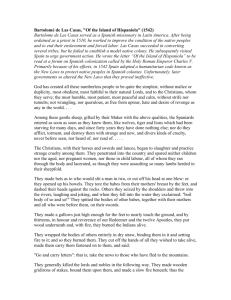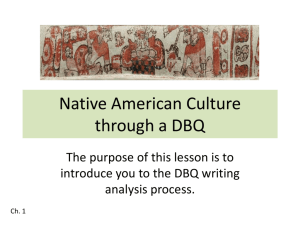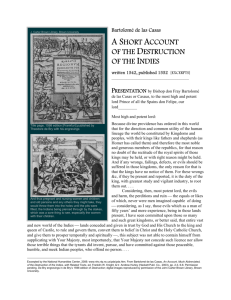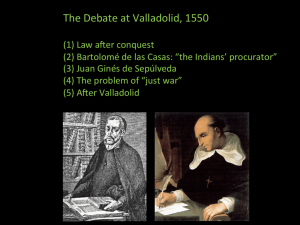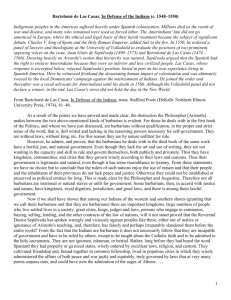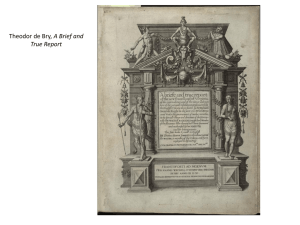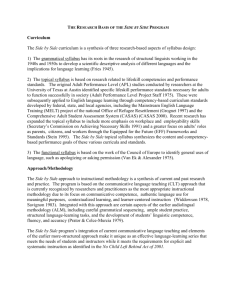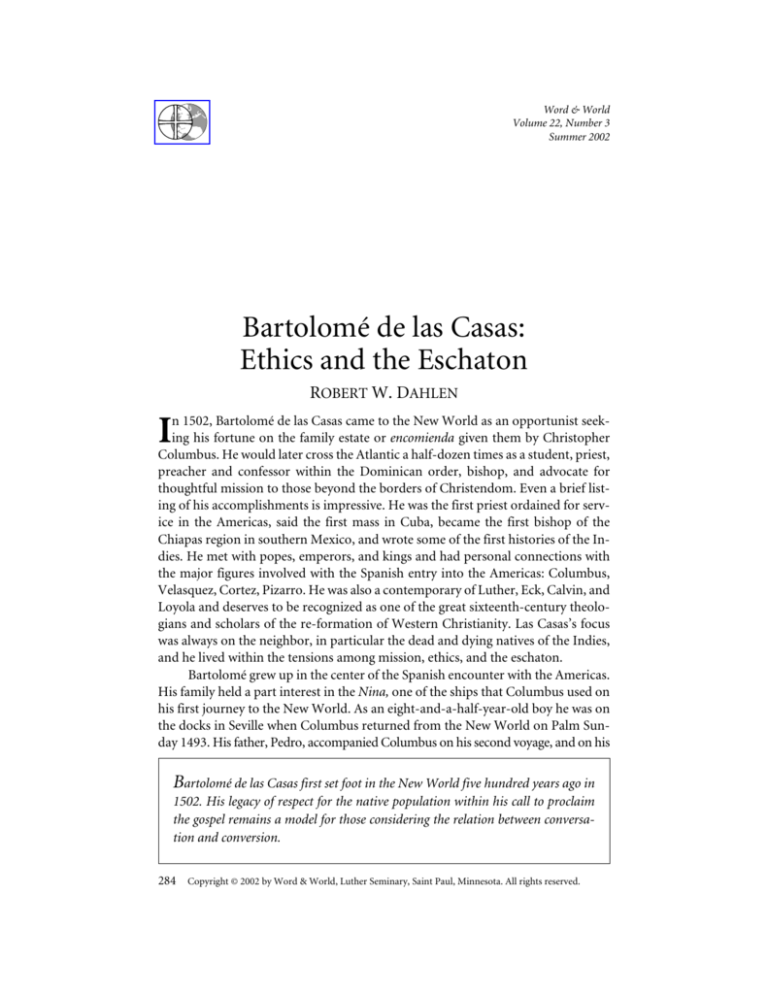
Word & World
Volume 22, Number 3
Summer 2002
Bartolomé de las Casas:
Ethics and the Eschaton
ROBERT W. DAHLEN
n 1502, Bartolomé de las Casas came to the New World as an opportunist seeking his fortune on the family estate or encomienda given them by Christopher
Columbus. He would later cross the Atlantic a half-dozen times as a student, priest,
preacher and confessor within the Dominican order, bishop, and advocate for
thoughtful mission to those beyond the borders of Christendom. Even a brief listing of his accomplishments is impressive. He was the first priest ordained for service in the Americas, said the first mass in Cuba, became the first bishop of the
Chiapas region in southern Mexico, and wrote some of the first histories of the Indies. He met with popes, emperors, and kings and had personal connections with
the major figures involved with the Spanish entry into the Americas: Columbus,
Velasquez, Cortez, Pizarro. He was also a contemporary of Luther, Eck, Calvin, and
Loyola and deserves to be recognized as one of the great sixteenth-century theologians and scholars of the re-formation of Western Christianity. Las Casas’s focus
was always on the neighbor, in particular the dead and dying natives of the Indies,
and he lived within the tensions among mission, ethics, and the eschaton.
Bartolomé grew up in the center of the Spanish encounter with the Americas.
His family held a part interest in the Nina, one of the ships that Columbus used on
his first journey to the New World. As an eight-and-a-half-year-old boy he was on
the docks in Seville when Columbus returned from the New World on Palm Sunday 1493. His father, Pedro, accompanied Columbus on his second voyage, and on his
Bartolomé de las Casas first set foot in the New World five hundred years ago in
1502. His legacy of respect for the native population within his call to proclaim
the gospel remains a model for those considering the relation between conversation and conversion.
284
Copyright © 2002 by Word & World, Luther Seminary, Saint Paul, Minnesota. All rights reserved.
Bartolomé de las Casas: Ethics and the Eschaton
return presented his son with a young native of Hispaniola (now Haiti and the Dominican Republic). This slave was baptized at the cathedral of Seville and given the
name Juanico. Juanico spent the bulk of his adult life as Bartolomé’s personal servant and companion, making Las Casas one of the first Europeans to enter a longterm relationship with a native of the Americas.1
APOCALYPSE IN THE SIXTEENTH CENTURY: EUROPEAN AND AMERICAN VIEWS
At the beginning of the sixteenth century Western Europe felt itself under
siege. The crusades of the previous centuries had failed to keep the Holy Lands in
Christian hands and Turkish sultans threatened to enter the heart of Europe. To
the south, the Muslims of North Africa had taken control of the western Mediterranean and challenged Italian trade routes. Within the Holy Roman Empire, the
followers of Jan Hus had been able not only to defend their faith, but to become a
major military force in Central Europe. All this happened within the context of
plagues that killed millions, economic collapse, and a climate dominated by religious intolerance, corruption, and political intrigue. As the century unfolded, with
the Protestant movement gaining strength and the Turkish threat increasing,
apocalyptic religious leaders from every camp were convinced that the Antichrist
had been released and the Last Judgment was near.
While there was a deep sense of impending doom permeating the dawn of the
“as Columbus traveled in the Indies he became convinced
he had entered Eden itself”
sixteenth century, there was also the growing expectation that something new was
being born. The Portuguese had traveled down the west coast of Africa and discovered new routes to the East. The printing press along with improved ships and
navigation allowed for the easier transport of goods and ideas. In 1492 Spanish
forces entered Granada and brought to a close a crusade that drove the Muslim
Moors from Europe. Even as the Turkish threat increased and the heresies of Luther and company tore at the unity of the Latin Church, Roman Catholic Europe
broke out of isolation, turned to the west, and within the course of a century was
redefined as the center of the world.2
As Columbus traveled in the Indies he became convinced he was visiting the
new heaven and new earth of Rev 21 and had entered Eden itself. During his fourth
voyage he came to the mountains near the mouth of the Orinoco and wrote that he
had been “completely persuaded in my own mind that the Terrestrial Paradise is
1Bartolomé de las Casas, The Only Way, ed. Helen Rand Parish, trans. Francis Patrick Sullivan (Mahwah, NJ:
Paulist, 1992) 12-13.
2Enrique Dussel, The Invention of the Americas (New York: Continum, 1995) 37ff. Dussel argues that prior
to 1492 Europe was peripheral and secondary when compared to Islam, which at the time exerted influence from
North Africa to the Phillipines. It was not until the defeat of the Turks at Vienna in 1681 and the rise of empire that
western Europe, as opposed to the Middle East, came to be the center of world history.
285
Dahlen
the place I have described.”3 It was here God had planted the tree of life, protected
it during the days of the flood, and from the fountains of this place the waters
spread out and formed the four rivers of Gen 2. This was more than simply a discovery of a previously unknown place on the globe. Columbus thought of his voyages as revelations from God, to be understood as preparing the way for the
conversion of the Gentiles, the recapture of Jerusalem, and the end of time.
Other early evaluations of the Americas were often not as overtly apocalyptic as
those of Columbus, but they still spoke of mystery and wonder. There were stories of
the fountain of youth, cities of gold, millions of souls to be converted to the true faith,
untold riches, tribes of women warriors and dog-headed men (an oblique reference to
the legends of St. Christopher). Remembering his first trip to Hispaniola in 1502, Las
Casas describes how the scent of paradise came to him long before he even saw it:
When ships come from Spain and begin to raise the first islands or any of the
coast of Tierra Firme, people aboard ship sense a marvelous fragrance, fresh
smells coming offshore. It is as if rose flowers were right there present to them.4
Europeans, however, were not the only people to be affected by the “discovery,” and they were not the only sixteenth-century people with apocalyptic anxieties and expectations. Many natives in the Americas carried complex cosmologies
that spoke of cycles of creation, destruction, and re-creation. The Aztecs and Mayans held that the world had been created five times, destroyed four times, and was
vulnerable to destruction once again. In 1428 the Aztec Tlacaelel gained control of all
of central Mexico, reformed the empire, and established a complex and bloody cycle of
worship and sacrifice around the cult of the warrior sun-god, Huitzilopochtli. Every
day this sun-god went through a cycle of light and darkness and was kept alive through
human sacrifices that were described as the blooming of flowers. The campaigns for
the capture of sacrificial victims were called the “flower wars,” and death was described using the most lurid floral metaphors:
There where the spears ring, where the shields clang, there are the white perfumed flowers, the flowers of heart. The flowers of the life-giver open their corollas, and the princes of the world inhale the perfume of the life-giver: it is
Tenochtitlan [Mexico].5
When the Spanish under Cortez entered Mexico in 1519 it was not simply an encounter between two peoples, but of two eschatons.
3For a discussion of Columbus’s religious convictions, see David E. Stannard, American Holocaust (Oxford
University Press, 1992) 195ff., or David M. Traboulay, Columbus and Las Casas (Lanham: University Press of America, 1994) 7ff. The depth of Columbus’s spirituality is hard to gauge. He could be cruel, petty, grandiose, and vicious,
and at the same time was always regular and humble in prayer and devotion. After his first voyage to the New World,
he signed his name Christoferens, “The Christ bearer,” followed by the initials “X, M, Y,” referring to St. Christopher,
the Virgin Mary, and John the Baptist, all having prepared the way for Jesus. While getting ready for his third voyage
he wore the robes of a Franciscan, and some suggest he was a lay member of that order. He was buried in a Carthusian monastery wearing those Franciscan robes.
4Las Casas, The Only Way, 64.
5Dussel, Invention, 104-105.
286
Bartolomé de las Casas: Ethics and the Eschaton
Enrique Dussel provides a profound examination of the Spanish conquest of
Mexico and argues that the encounter between American and European eschatologies is a key to understanding these events. The Spanish came to Mexico under the
flag of conquesta, a crusade to free the Holy Lands from Islam and establish Christianity among all the nations. Aztec tradition provided their emperor, Montezuma,
with three ways to understand the Spanish presence: (1) Cortez and company were
merely humans set on invading Mexico, (2) Cortez was a god, probably Quetzalcohuatl the flying serpent who, after being exiled from Mexico by pre-Aztec peoples, was returning to claim his rightful throne, or (3) Cortez only wore the mask of
Quetzalcohuatl and was, in fact, another—probably malevolent—deity who would
destroy the fifth sun and bring the world to an end. Montezuma initially worked
within the logic of the second option and gave Cortez the throne. Cortez blundered
his way through Mexico for the next year and a half before completing his conquest. The peoples of Mexico would later come to realize that perhaps Montezuma’s first and third options were far more accurate.6
AN AMERICAN HOLOCAUST
7
When Bartolomé’s father, Pedro de las Casas, accompanied Columbus on his
second voyage to the New World, they stopped at the Canary Islands for supplies.
Among the provisions were eight pigs. By the time the ships reached Hispaniola a
number of the crew were sick and dying. Some modern researchers speculate that a
virus, probably an influenza, moved from the hogs to humans. The encounter between European and Indian peoples resulted in a wave of death passing through
the Americas. The first ripples were felt as Columbus landed, they continued
through the next four centuries, and some would say they are still pounding in on
places like the Mayan communities of Central America, the Brazilian rain forests,
Las Casas’s diocese of Chiapas, and rural and urban Indian communities throughout Canada and the United States. Even in places far from the tropical islands first
visited by Europeans, the post-Columbian plagues of smallpox, tuberculosis, measles, famine, war, and all the rest came to form the backdrop of native peoples’ understanding of reality.8 Death provided the eschatological context for Las Casas’s
work, and it is here that he speaks with greatest clarity to our times.
6Ibid., 91-132. Dussel argues, quite convincing y, that Juan Diego’s visions of the Virgin of Guadalupe in December 1531 and their subsequent interpretation in Latin America involve a rejection of both Aztec and Spanish
gods and their masculine eschatologies. The Virgin appears at the site of the pre-Aztec temple ofTonantzin (our little mother) and is clearly native. Her message is not one of war, conquest, sacrifice, or fertility, but revolves around a
refuge for the forsaken. She provides the roses, the sacrificial flowers, as proof of her message and only asks that the
faithful build—or perhaps, rebuild—her temple so that both native and European believers might return to worship and pray.
7This is the title of David Stannard’s book, and I am deeply indebted to the clarity with which he presents the
story. It is a brilliant piece of research into what happened when European culture and disease entered the Americas,
though it is not to be read by the faint of heart. He asks a simple question, “What kind of people would do this to
other human beings?” and the angry haunted answer comes back, “Christians!”
8For Native accounts of post-Columbian disease in the upper Midwest and eastern Canada, see Basil Johnston, Ojibway Heritage (Toronto: McClelland and Stewart, 1979) and William Warren, History of the Ojibway People
287
Dahlen
From the beginning, European observers had some idea they were watching a
population in rapid decline. Las Casas and his contemporaries speak again and
again of populations greater than any sixteenth-century European city and tell of
how “it is as though God had crowded these lands with the majority of mankind.”9
In 1492 Columbus thought Hispaniola was home to two to three million people.
The first accurate census taken in 1510 reports only twenty to thirty thousand natives remained. By 1540 there were only three hundred. In 1610 the bishop of Santo
Domingo said there was no need to provide services for Indians on Hispaniola because there were no Indians on the island—there probably hadn’t been any for a
generation. By the 1530s and ’40s similar patterns of destruction were taking place
from Mexico to the coastlands of Peru. Some estimate that the population of the
New World continued to fall until well into the nineteenth century.10 We now
know that pre-Columbian Indian populations had little resistance to many Old
World diseases, such as smallpox, measles, and influenza, and that these diseases,
in concert with political actions and genocide, emptied the New World. But Las
Casas reminds us of hundreds of thousands and more slaughtered by slavery,
Toledo steel, and fighting dogs, and he refused to absolve Europeans of the deaths
that left the Americas all but empty.11
The death that stalked the Indies stands in sharp contrast to the Europeans’
initial impression of native peoples. In 1492 Columbus reported that the people
were well-built, handsome, timid, generous, and when they share a gift they “show
as much love as if they were giving their hearts.”12 He thought he had entered paradise and was experiencing both a return to Eden and the gathering of the nations of
Isa 66 and Rev 7. Columbus, however, had also traded in slaves in Africa and saw in
(St. Paul: Minnesota Historical Society, 1885; reprinted 1984) 54 ff. Both of these native authors make mention of
ancient creation stories that pre-date European contact. But the sixteenth- or early seventeenth-century stories of
disease and famine are crucial to native self-understanding. These stories relate how the Ojibway abandoned traditional village sites on the shores of “great waters” in the east and moved west. Most scholars now think that, once introduced to native populations, disease moved through North America a generation ahead of actual European
contact.
9Bartolomé de las Casas, The Devastation of the Indies, trans. Herma Briffault (Baltimore: Johns Hopkins,
1992) 28.
10For a discussion of the extent of the depopulation of the Americas, see Gustavo Gutiérrez, Las Casas: In
Search of the Poor of Jesus Christ, trans. Robert Barr (Maryknoll: Orbis, 1993) 461-464, and Stannard, Holocaust,
261-268. In 1939 Alfred Kroeber of the University of California at Berkeley pegged the total pre-Columbian population of the Americas at 8.4 million, with less than a million north of Mexico. Kroeber recognized his numbers were
based on a great deal of speculation and suggested that a detailed interdisciplinary approach be taken to answer the
question. By the 1960s the Berkeley research suggested the totals were over one hundred million, and more current
research indicates that all estimates have been far too low. While pre-Columbian populations are subject to debate,
the horror of the story sinks in when you realize that no matter what numbers you accept at the beginning, by the end
so many are dead! Even the most conservative estimates suggest a decline of at least 25% by 1825, while others suggest total declines of over 90%.
11As a child, I remember watching Walt Disney’s Zorro on my grandparents’ TV. It was very much “swordplay”—pure entertainment and a delightful, exotic combination of acrobatics and flash. Now, I read Las Casas and
see what Spanish blades were designed to do, namely, slice through human flesh. See almost any page in Las Casas’s
The Devastation of the Indies, as well as his larger The History of the Indies, selections of which are printed in Witness:
The Writings of Bartolomé de las Casas, ed. and trans. George Sanderlin (Maryknoll: Orbis, 1992) 23ff.
12Stannard, Holocaust, 63.
288
Bartolomé de las Casas: Ethics and the Eschaton
the peoples of the New World a commodity that could be converted to cash for
such pious ventures as the recapture of Jerusalem. He brought a few slaves back to
Spain on his first voyage and expanded the slave trade on subsequent trips. Aside
from Las Casas’s Juanico, little is known about the fate of this human cargo.
“As disease and slavery quickly spread, the Indians began to resist
the European entry into their lands. To the amazement of the
Europeans, they also resisted the Christian faith.”
As disease and slavery quickly spread, the Indians began to resist the European entry into their lands. To the amazement of the Europeans, they also resisted
the Christian faith. Eschatological visions on both sides of the encounter broke
down. The old gods of Middle America had not returned, and neither had the
Spaniards with their Italian navigator entered Eden. Very different visions of the
eschaton soon took shape. The “discoverers” soon began using military metaphors
borrowed from their crusading experience against the Moors to explain their relationship with the natives of the New World. A brief examination of three different
European theological treatments of the Native American “problem” shows the ugly
depths to which a so-called “Christian” understanding of the neighbor can go.
Juan Ginés de Sepúlveda was a translator of Aristotle from Cordova. As Las
Casas argued for more humane treatment of the Indians, Sepúlveda wrote a tract
defending the conquest of the Americas. Using Aristotelian categories he defined
the Indians as barbarians by nature. He recognized that in the first century Jesus
and the apostles had the power of miracles to convert unbelievers, but then noted
that times have changed. Now, while miracles are rare, God has given the church
kings and princes who have the power to suppress any impediments to belief. In
other words, the sword is now to be used to “compel them to come in” (Luke
14:23).13 The fact that so many died either in battle or as slaves before they became
Christians did not matter. The focus of his eschatology was on the virtuous good
deeds of the ones who on the day of the Lord wield the sword in the name of the
gospel so that others might be saved.
This crusading mentality was later replaced by one driven by the more powerful engine of economics. During the 1530s the Spanish finally found in Peru the
huge quantities of gold that Columbus and so many others had searched for since
1492. García de Toledo was a Dominican, a cousin of the viceroy of Peru, and in
1571 he wrote a letter, known as the Yucay Opinion, in which he set out to defend
Spanish rule in Peru and once and for all silence Las Casas. He begins by saying he
once sympathized with Las Casas’s position concerning the Indians, but as he
13For a summary of Sepúlveda, see Gutiérrez, Las Casas, 126ff. and Parish, in her introduction to Las Casas,
The Only Way, 46-47. In response to Sepúlveda, it is interesting to note that for many in Latin America entry into the
faith is traced back not to conquest, but to Juan Diego’s vision of Mary at Guadalupe on December 12, 1531. It seems
that, when pressed, the Holy Spirit does revert to miracles!
289
Dahlen
gained more experience in Peru, he came to see that the older man was not so
much concerned about the Peruvian natives as he was full of hatred for Spain.
Toledo reports that Las Casas’s thinking was twisted and grotesque and that when
he talked about Indian rights he got so angry he sputtered. Toledo also became
convinced that God had filled the mountains of Peru with gold and silver so that
Christians would be drawn to the place and bring the natives to Christ. He tells a
little fable to make his point. God behaved
with these miserable pagans [the Indians] and with us as a father with two
daughters. One was very pale and fair, and modest, graceful and charming, while
the other was altogether hideous—bleary-eyed, stupid, and crude. When it came
time to marry them off, there was no need of so much as giving the first girl a
dowry. She only needed to be seated in a palace, where all the lords vied with one
another over who would marry her. With the ugly, lazy, foolish, clumsy one,
there was nothing to do but give her a great dowry—many jewels, rich and
sumptuous, and expensive clothing—and leave her to heaven.14
Of course, Toledo knows Matt 28 and Rev 7 and proclaims that God chooses to bring
members of all nations to salvation. But not all the peoples of the world are so naturally blessed as those of Asia Minor and Europe. In particular, the poor Indians were
so ugly, unworthy, and dull that
[God] gave them veritable mountains of gold and silver, fertile lands and fair,
since, in this sweet odor there would be people who, for God, would be willing to
go preach the gospel to them and baptize them, and these souls would become
spouses for Jesus Christ.15
Toledo reduces all Las Casas’s concerns about mission, justice, human rights,
war, genocide, and even the gospel itself to matters relating to the flow of wealth.
As Gutiérrez puts it, Toledo can be summarized in four words: “No Gold, No
God.”16 Las Casas answers such arguments by calling them simple idolatry, and his
writing includes many stories of how the Indians were convinced the Spaniards
were worshipers of gold.
Forcibly compelling the Indians to enter the church led to countless deaths
that were initially justified as unfortunate collateral damage arising from the Conquistadores’ faithfulness. The use of the sword along with their pursuit of wealth
were justified in terms of the greater good of the Indians’ inclusion within the body
of Christ. But as Europeans had more contact with the Indians, and as relations
broke down through slavery, war, and disease, there developed an obsession with
the “sins” of the Indies, namely, idolatry, human sacrifice, cannibalism, and “sodomy.” Instead of seeing the Indians as inhabitants of paradise, ready to be brought
into the arms of a Mother Church, the “discoverers” and their heirs viewed them as
subhuman, bestial vermin, to be eradicated in preparation for the coming of the
14Gutiérrez,
15Ibid.,
425.
16Ibid., 429.
290
Las Casas, 424.
Bartolomé de las Casas: Ethics and the Eschaton
kingdom. God’s apocalyptic judgment had fallen on the Indians after generations
of sin, just as God’s judgment was poured out on the Amorites when the children
of Israel under Joshua entered the promised land.17 The goal of this eschaton was
not bringing the nations into the church. It was genocide.
As native populations declined, the force of this argument seemed to grow,
reaching its climax in the United States some four hundred years after the arrival of
Columbus. For example, in 1864, there was a skirmish between white settlers and
unidentified Indians on the Colorado frontier. In response to the death of some
settlers, a Methodist preacher with a commission in the militia, Colonel John Chivington, led a unit of seven hundred soldiers into the Sand Creek Cheyenne and
Arapaho village. Because most of the men had gone on a buffalo hunt, there were
only about six hundred in the village, mainly women and children. The colonel
gave his troops orders to kill them all—children as well. “Nits make lice,” was
Chivington’s motto. A Colorado newspaper reported, “Cheyenne scalps are getting
as thick as frogs in Egypt.” Years later, President Theodore Roosevelt would say
that these events at Sand Creek were “as righteous and beneficial a deed as ever
took place on the frontier.”18 The incident was described in apocalyptic terms. It
was a cleansing of the land, a righteous deed, and images are drawn from God’s
judgment on Pharaoh’s Egypt. While some would speak nostalgically about the
so-called “vanishing American,” few doubted there would come a day when there
would be no Indians in the United States.19
LAS CASAS’S WITNESS: RAVENING WOLVES AMONG FLOCKS OF SHEEP
Beginning with his ordination in 1507, continuing through 1512-1514 when
he gave up his estate and preached his first sermon against slavery, and on to his
death in 1566, Las Casas sought to proclaim the faith of the church in the New
World. He pleaded that Europeans take seriously the rights and culture of the Indian, saying the only way to bring them into the church was through peaceful persuasion and by living righteous examples of the Christian life.20 While he was
opposed at every corner, for a brief moment Las Casas was heard as the Spanish
17The theme of Israel destroying the natives of the promised land runs through several books of the Old Testament. Destruction is not the last word there, however. Joshua never completes the conquest, and significant preconquest populations always remain in the land where they threaten, tempt, and sometimes provide refuge and help
for Israel. The key theological issue is not that Israel should destroy the natives of the land, but how Israel is to remain
faithful even in the presence of her neighbors.
18See Stannard, Holocaust, 129-134, for excerpts from the testimony given at the investigation of the Sand
Creek Massacre.
19See Henry Benjamin Whipple, Light and Shadows of a Long Episcopate (New York: Macmillan, 1912).
Whipple was the Episcopal bishop of Minnesota from 1859 to the early 1900s. He was an advocate for Indian rights
and education and pleaded with Lincoln for clemency for the Sioux sentenced to death after the Minnesota Uprising
of 1863. But even Whipple thought of the Indians as a vanishing race and seemed to view any native mission as a
short-term venture.
20See Las Casas, The Only Way, and In Defense of the Indians, trans. and ed. Stafford Poole (Dekalb: Northern
Illinois University, 1992). Las Casas’s arguments are simple and repetitive. There is only one way to bring the Indians into the church, and that is through the good examples of faithful Christians.
291
Dahlen
courts and university system under Charles V, in concert with the papal courts, engaged in formal debates concerning their treatment of native peoples.
For these debates, Las Casas prepared his major works: The Only Way, In Defense of the Indians, and other pieces. Here he presented data—page after page of
his own firsthand recollections of events in the New World and hours of carefully
documented testimony. He was a Thomistic scholar trained in canon law and eloquently spoke to legal issues, using all the standard sources of the time. He argued
against those who used Aristotle to prove that the Indians were barbarians by nature, and even defended the practice of human sacrifice by showing that it was not
inhumane butchery, but a people’s honest, but misguided, offering up to their gods
of what was most precious.21
From the point of view of the Indians the debates were a failure, and the eschatological justifications for the Spanish actions in the New World held the day.
Those who heard him were able to either ignore or rationalize Las Casas’s witness
to atrocities. He was accused of blatant exaggeration, heresy, and of hating his own
people, who had been authorized by the pope to bring the gospel and sacraments to
the New World. Even when he was able to influence Charles V and secure new laws
for the treatment of the natives, slavery and slaughter continued. By the end of his
life Las Casas had come to the conclusion that the crown of Spain had never held legitimate authority over the Indies, and only a European withdrawal from the New
World could bring the gospel to the Indians. Only after the wars had ceased and after
both African and American slavery had ended could a small number of teachers and
righteous examples of the faith peacefully lead the natives to an acceptance of the
gifts of Christ.22 Long after his death scholars wrote in opposition to Las Casas. Still,
Las Casas offers a unique and revolutionary way of understanding the relationships
among the faithful, their neighbors, and the promise for the ends of the age.
For Las Casas the pivotal moment in Christian eschatology is not the discovery of the New World or any other point of cosmic transition. Rather, it is the simple direct ethical encounter the faithful have with their neighbor, in particular the
one in need (Matt 25:31ff.). One of my colleagues summarizes all of Las Casas’s
thought like this, “You cannot save a dead Indian—and you’re going to hell for
killing him.”23 Las Casas quotes St. Augustine concerning the heart of his message:
If someone is damned to hellfire by Christ saying to him or her, “I was naked and
you did not clothe me,” to what hellfire will they be damned to whom He says, “I
was clothed and you stripped me!”...[Y]ou think to strip a pagan in order to
clothe a Christian....When you as a Christian strip someone for being a pagan,
you cancel a convert.24
21Las
Casas, In Defense of the Indians, 221ff.
Las Casas, The Restoration of the Indies, in Sanderlin, Witness, 168-173.
23Robert Kelly, pastor of the People’s Church, Bemidji, Minnesota, a native-centered worshiping community supported by the Northwest Minnesota Synod, ELCA. Pastor Kelly has read much of Las Casas, and reports that
while visiting Peru he was shown potato terraces high in the mountains that have not been used since Inca times, evidence that local populations have yet to recover from the conquest.
24Las Casas, The Only Way, 162.
22See
292
Bartolomé de las Casas: Ethics and the Eschaton
It is in the neighbor, in particular in the dying native of the New World, that
Las Casas sees the heart of Christian expectation and hope for the future. Unlike
his contemporaries, such as Columbus, who saw the eschaton in terms of the capture of Jerusalem, the gathering of the nations into the church, or a return to
Eden, Las Casas saw the door to the future turn on the hinge of those who were being stripped of their goods, enslaved, or whose bodies were split by cold steel and
torn apart by fighting dogs. If the Christian could not see Christ in the neighbor
who suffers, there was no seeing of Christ in the future—except in terms of judgment and hell.
“there is only the Christian and the vulnerable neighbor,
and all depends on what happens next”
Las Casas’s firsthand experience with the Spanish troops in Cuba and other
places provided him with some of his most powerful arguments concerning the
connection between basic Christian ethics and the eschaton. He leaves no room for
abstraction or subtle argumentation. There is only the Christian and the vulnerable
neighbor, and all depends on what happens next. This is what he saw in the town of
Caonao as some two thousand natives gathered in a town square to watch as the
Spaniards led off another thousand of their number into slavery:
There was a custom among the Spaniards that one person, appointed by the
captain, should be in charge of distributing to each Spaniard the food and other
things the Indians gave. And while the captain was thus on his mare and the others mounted on theirs, and the father himself [Las Casas] was observing how the
bread and fish were distributed, a Spaniard, in whom the devil is thought to have
clothed himself, suddenly drew his sword. Then the whole hundred drew theirs
and began to rip open the bellies, to cut and kill those lambs—men, women,
children, and old folk, all of whom were seated, off guard and frightened, watching the mares and the Spaniards. And within two credos, not a man of all of them
there remains alive.
The Spaniards enter the large house nearby, for this was happening at its
door, and in the same way, with cuts and stabs, begin to kill as many as they
found there, so that a stream of blood was running, as if a great number of cows
perished. Some of the Indians who could make haste climbed up the poles and
woodwork of the house to the top and thus escaped....
Another outrage occurred which should not be left untold, so that the
deeds of our Christians in these regions may be observed. When the cleric [Las
Casas] entered the large house where I said there were about 500 souls—or
whatever the number, which was great—and saw with horror the dead there and
those who had escaped above by the poles or woodwork, he said to them, “No
more, no more. Do not be afraid. There will be no more, there will be no more.”
With this assurance, believing that it would be thus, an Indian descended, a
well-disposed young man of twenty-five or thirty years, weeping. And as the
293
Dahlen
cleric did not rest but went everywhere to stop the killing, the cleric then left the
house. And just as the young man came down, a Spaniard who was there drew a
cutlass or half sword and gives him a cut through the loins, so that his intestines
fall out.
The Indian, moaning, takes his intestines in his hands and comes fleeing
out of the house. He encounters the cleric...and the cleric tells him some things
about the faith, as much as the time and anguish permitted, explaining to him
that if he wished to be baptized he would go to heaven to live with God. The sad
one, weeping and showing pain as if he were burning in flames, said yes, and with
this the cleric baptized him. He then fell dead on the ground.
Of all that has been said, I am a witness. I was present and saw it; and I omit
many other particulars in order to shorten the account.25
Bartolomé de las Casas tends to play on a limited instrument, saying over and
over again that when so-called “Christian” Europeans destroy the peoples of the
Indies they are not witnesses to Christ, but deny the faith and condemn themselves
to hellfire. He contrasts what he has seen in the New World with the intentions of
Christ:
Again, by the way He preached the gospel, Christ willed that His missionaries
should be meek as lambs, simple as doves....But the way of first conquering pagans in war does not smack of the meekness of lambs nor the simplicity of doves.
It is all a roar of lions, bears, tigers, all a howling of wolves, a howling of horrible
monsters, it is crafty as a fox at maliciousness. It almost outdoes the devil himself
in pride and ferocity of thought and word and deed. Warrior preachers are—or
are sent as—ravening wolves among flocks of sheep, not flocks of sheep among
ravening wolves. And that is an utter contradiction of the true way.26
ROBERT W. DAHLEN, a member of the Word & World Advisory Council, is pastor of Ekelund
and Faith Lutheran Churches, Goodridge, Minnesota.
25Sanderlin,
26Las
294
Witness, 51-53.
Casas, The Only Way, 124-125.

